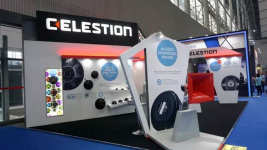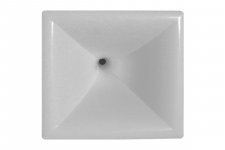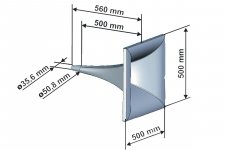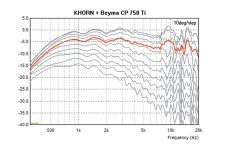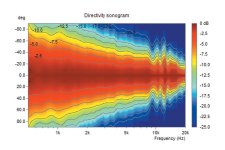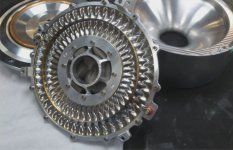Lots of good info! The low frequency performance is impressive..looks like it'll make smaller synergy horns obsolete by eliminating the need for close spacing at the throat.
I think 300hz is probably safe when combined with direct radiators but it might be wise to raise the crossover a bit if combined with a high power mid-bass horn section. They mention that the area is approximately the same as a 5.5" dome. It has 1mm of linear travel. It can only move so much air. For a very loud and clean horn-loaded point source PA system I would use it above 450hz.
agreed. I think that this is the kind of driver that changes the way people design systems. Retrofitting an older system doesn't do it justice. Makes me look for a 2" throat large constant directivity horn I can actually buy, except what I really need/want is a smaller one that would look good in my living room, except no point in that while it remains OEM only
The single red horn shown above is most likely a K-Horn.
Attachments
Last edited:
As previously suggested:
the Axi2050 + appropriate horn (the size of a K402) + one of Celestion's excellent 18" woofers in a big (front-loaded or br) cab would make a killer 2-way.
Another option would be a MEH, similar to Cask05's.
the Axi2050 + appropriate horn (the size of a K402) + one of Celestion's excellent 18" woofers in a big (front-loaded or br) cab would make a killer 2-way.
Another option would be a MEH, similar to Cask05's.
Last edited:
Some random thoughts from sitting through the whole hour of the Celestion video:
1) Celestion's justification for the axiperiodic design is that the BMS coaxial design has HOMs. But there are two ways to solve the HOM issue in the BMS design:
a) put both diaphragms equidistant from the throat, which is exactly what JBL is doing in their D2 drivers
b) I have a hunch that HOMs are lessened with wider waveguide angles. I've definitely noticed much worse HOMs on very narrow angle horns. (Car audio horns have angles as narrow as ten degrees.)
2) The manufacturing of the CD sounds painfully difficult.
3) People keep comparing this to a Unity horn. Keep in mind that a Unity horn will still have dramatically more output below about 700Hz because the AXI 2050 is displacement limited. In the video they mention that the AXI 2050 phase plug is less than one millimeter from the diaphragm. A Unity horn has something like 4X the displacement of an AXI 2050 in the range of 350Hz to 1400Hz.
This isn't to dismiss the design; it makes a lot of sense for Celestion because it's a simple solution to a common problem; a Unity horn will produce more output for less money, but it's also hideously complex.
1) Celestion's justification for the axiperiodic design is that the BMS coaxial design has HOMs. But there are two ways to solve the HOM issue in the BMS design:
a) put both diaphragms equidistant from the throat, which is exactly what JBL is doing in their D2 drivers
b) I have a hunch that HOMs are lessened with wider waveguide angles. I've definitely noticed much worse HOMs on very narrow angle horns. (Car audio horns have angles as narrow as ten degrees.)
2) The manufacturing of the CD sounds painfully difficult.
3) People keep comparing this to a Unity horn. Keep in mind that a Unity horn will still have dramatically more output below about 700Hz because the AXI 2050 is displacement limited. In the video they mention that the AXI 2050 phase plug is less than one millimeter from the diaphragm. A Unity horn has something like 4X the displacement of an AXI 2050 in the range of 350Hz to 1400Hz.
This isn't to dismiss the design; it makes a lot of sense for Celestion because it's a simple solution to a common problem; a Unity horn will produce more output for less money, but it's also hideously complex.
So the 1mm figure is peak to peak. Half of what I was thinking. Still a very welcome improvement in wideband compression driver tech. Consistent and efficient manufacturing will decide whether it lasts on the market. (A bit obvious I know)
FIR is making some of the problems solved by this driver into trivial issues in the sound reinforcement world. Combining the two would be very nice of course. All depends on the price compared to BMS.
FIR is making some of the problems solved by this driver into trivial issues in the sound reinforcement world. Combining the two would be very nice of course. All depends on the price compared to BMS.
In the video Jack Oclee-Brown shows just a few steps and details of the (FEM) modeling proces.
Low frequency reproduction is a product of displacement, true. A factor is diaphragm surface area.
The Axi2050's diaphragm is huge compared to those in both BMS Coaxials and the D2.
In the Restomod project a 10" cone driver is replaced by the Axi2050...
A Unity horn may have more output between 300-2000Hz, but there's also a very complex crossover in the middle of that range.
Low frequency reproduction is a product of displacement, true. A factor is diaphragm surface area.
The Axi2050's diaphragm is huge compared to those in both BMS Coaxials and the D2.
In the Restomod project a 10" cone driver is replaced by the Axi2050...
A Unity horn may have more output between 300-2000Hz, but there's also a very complex crossover in the middle of that range.
Last edited:
If it is to be compared to something, that should be BMS 4592nd which has Xmax=0,8 mm and 89mm voice coil diameter - which is declared to put up with 1300W peak. Mid is declared 150W at 400Hz (AES)
http://www.bmsspeakers.com/fileadmi...1-04_coaxial_neodymium_compression_driver.pdf
Axi2050 has Xmax=0,5mm but 125mm voice coil diameter and much larger cone surface which is product of pattern built in it and its diameter.
If BMS 4592nd found its place in PA and home use, Axi2050 surely will.
http://www.bmsspeakers.com/fileadmi...1-04_coaxial_neodymium_compression_driver.pdf
Axi2050 has Xmax=0,5mm but 125mm voice coil diameter and much larger cone surface which is product of pattern built in it and its diameter.
If BMS 4592nd found its place in PA and home use, Axi2050 surely will.
Last edited:
Agreed Zvu.
Moreover, the diaphragm of the Axi2050 is ultra thin. Combined with the phaseplug this leads to high efficiency, while reducing undesired interferences.
Compared to other wideband drivers the Celestion's design is very elegant.
There's only one moving part, but it's SOTA.
I think the Axi2050 constitutes real progress, it's the fruit of bright minds using advanced technology.
Celestion has spent over 15 years to develop proprietary software called Projector. It allows them to understand the activity of each little tweak in a model of a loudspeaker design.
Projector takes the principles of FEA – finite element analysis (a mathematical approach to solid mechanics) – and applies them to loudspeaker MANUFACTURE: mechanically, thermally, acoustically and electrically.
Moreover, the diaphragm of the Axi2050 is ultra thin. Combined with the phaseplug this leads to high efficiency, while reducing undesired interferences.
Compared to other wideband drivers the Celestion's design is very elegant.
There's only one moving part, but it's SOTA.
I think the Axi2050 constitutes real progress, it's the fruit of bright minds using advanced technology.
Celestion has spent over 15 years to develop proprietary software called Projector. It allows them to understand the activity of each little tweak in a model of a loudspeaker design.
Projector takes the principles of FEA – finite element analysis (a mathematical approach to solid mechanics) – and applies them to loudspeaker MANUFACTURE: mechanically, thermally, acoustically and electrically.
Last edited:
On a sidenote, in my experience diaphragm excursion is often inversely proportional to acoustic fidelity.
Excursion is relevant for PA where size, weight and high output levels are in conflict with each other,
or if you want to squeeze 30-5000Hz out of a lossy 5.5" woofer.
Developing a mechanical device to overcome (or fight?) the laws of physics doesn't necessarily result in proper transmission of the signal.
There's more than one reason why many professionals in the field still consider the old Quad ESLs to be the pinnacle of high-fidelity.
Excursion is relevant for PA where size, weight and high output levels are in conflict with each other,
or if you want to squeeze 30-5000Hz out of a lossy 5.5" woofer.
Developing a mechanical device to overcome (or fight?) the laws of physics doesn't necessarily result in proper transmission of the signal.
There's more than one reason why many professionals in the field still consider the old Quad ESLs to be the pinnacle of high-fidelity.
Last edited:
Why did Samsung, owner of Harman International, partner with Steinway Lyngdorf in promoting 'The Wall' display?
An externally hosted image should be here but it was not working when we last tested it.
Last edited:
On a sidenote, in my experience diaphragm excursion is often inversely proportional to acoustic fidelity.
Excursion is relevant for PA where size, weight and high output levels are in conflict with each other,
or if you want to squeeze 30-5000Hz out of a lossy 5.5" woofer.
Developing a mechanical device to overcome (or fight?) the laws of physics doesn't necessarily result in proper transmission of the signal.
There's more than one reason why many professionals in the field still consider the old Quad ESLs to be the pinnacle of high-fidelity.
Its a compression driver so it's far more effective at converting excursion to sound than a woofer of the same size. Its rated for 108db/1w sensitivity and 150w power handling and a 300Hz crossover. I somehow doubt within those ratings the dome will hit the phase plug.
In 1978, Sony engineers had similar objectives with their honeycomb diaphragms:
"For accurate pistonic motion of loudspeaker diaphragm which of course guarantees high fidelity sound reproduction, this new loudspeakers were developed. This loudspeaker, having honeycomb sandwich diaphragm which is derived at multiple points to eliminate low-order break-up vibrations, has only 1/20 diaphragm deformation and also four times wider pistonic motion range, compared with current one".
Hello,
Have the the small cavities of the diaphragm material an influence on the reproductible frequency range ?
Its a compression driver so it's far more effective at converting excursion to sound than a woofer of the same size. Its rated for 108db/1w sensitivity and 150w power handling and a 300Hz crossover. I somehow doubt within those ratings the dome will hit the phase plug.
I am confident the diaphragm won't touch the phase plug under normal use. Reliability issues would be revealed by the pre-production engineering samples in circulation among OEM clients.
Last edited:
Hello,
Have the the small cavities of the diaphragm material an influence on the reproductible frequency range ?
I don't think the features have a major impact on bandwith per se. It's the design of the diaphragm including the features that negate/overcome the issues commonly associated with large diaphragms.
This doesn't sound like anything extraordinary.
However, the solution Celestion's Lennon & McCartney have come up with, is beyond the Beatles.
Apparently, the science behind it has more in common with turbine technology than traditional loudspeaker design.
Last edited:
Apparently, the science behind it has more in common with turbine technology than traditional loudspeaker design.
Yup, here is a larger prototype of the driver getting a new diaphragm
Attachments
The original image.
Is it an hydroformed diaphragm ?
It seems be extremely rigid and thin in order to offer some deformation, The structure may be affected by the metal fatigue ?
- Home
- Loudspeakers
- Multi-Way
- New Celestion "AxiPeriodic Driver"
